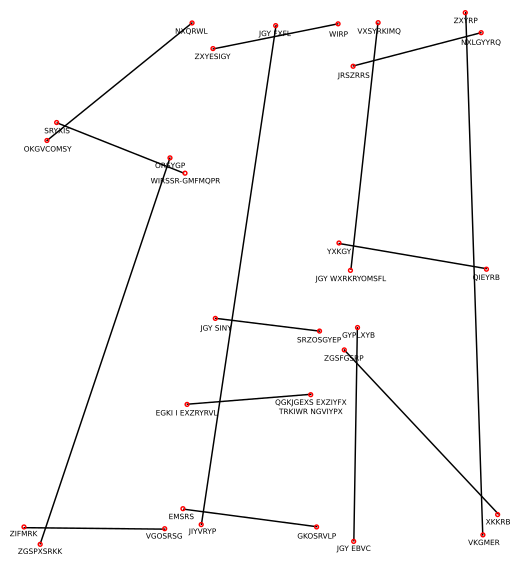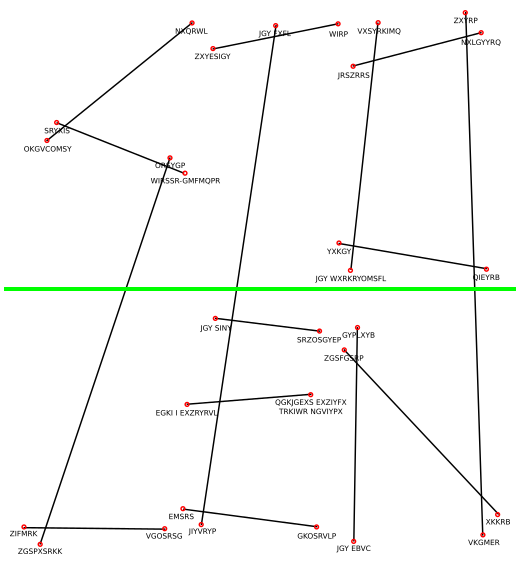| Home Register Puzzles Solve Teams Statistics Rules Solving Guide F.A.Q. Archive mezzacotta |
Solution: 4B. Art Elsewhere
This puzzle presents a series of 15 paintings, plus a set of 15 word blanks with shaded letters. At first glance, one might expect to have to identify the paintings, insert the titles into the word blanks, and read a hidden message from the shaded letters.
The first step, identifying the paintings, can be done through a mixture of familiarity with some of the individual paintings, with the styles of likely artists, or by brute force using a reverse image search engine such as Google Images. The paintings are:
- Still Life with Marigolds and Persimmons, by Margaret Olley
- Young Woman With A Japanese Umbrella, by Pierre-Auguste Renoir
- Swans Reflecting Elephants, by Salvador Dalí
- Girl with a Pearl Earring, by Johannes Vermeer
- Saint Francis Xavier, by Miguel Cabrera
- Water Lily Pond with Irises, by Claude Monet
- Composition No. 8, by Piet Mondrian
- Wheat Field with Cypresses, by Vincent van Gogh
- Isaac Winslow and his Family, by Joseph Blackburn
- A Lady and Gentleman in Black, by Rembrandt van Rijn
- Death of Constable Scanlon, by Sidney Nolan
- Nymph and Shepherd in a Landscape, by Cornelis van Poelenburgh
- Abduction Of Proserpine On A Unicorn, by Albrecht Dürer
- Saint George Killing the Dragon, by Bernat Martorell
- Entry of Christ into Jerusalem, by Anthony van Dyck
Having identified the paintings and their artists, it can quickly be seen that neither painting titles nor artist names seem to fit into the provided blank word slots.
The twist to this puzzle which needs to be realised is that all of the Thursday puzzles in this competition are interrelated, and rely on information from other puzzles. One might in fact first notice this using the painting titles, which contain all of the 30 words clued by the cryptic clues in puzzle 4C. Crossover Word. However that association leads ultimately to the solution to Crossover Word, not this puzzle.
For this puzzle, the required information is the artist names. Once we realise that the puzzles are interconnected, it is possible to find the artist names hiding in another puzzle: 4D. Signs of Change. The last page of that puzzle contains 30 red dots, each labelled with a seemingly random series of nonsense letters. These letters are in fact a substitution cipher, which can be decrypted using some basic cipher solving techniques based on letter patterns and frequencies. If you suspect that the encoded words are the artist names (as one might once the interlinked nature of the puzzles is discovered), that makes the task considerably easier.
It turns out that the 30 enciphered strings are the 15 artist first and last names:
| Artist | Ciphered name |
|---|---|
| MARGARET OLLEY | ZGSFGSRP / XKKRB |
| PIERRE-AUGUSTE RENOIR | WIRSSR-GMFMQPR / SRYXIS |
| SALVADOR DOMINGO FELIPE JACINTO / DALI I DOMENECH | QGKJGEXS EXZIYFX TRKIWR NGVIYPX / EGKI I EXZRYRVL |
| JOHANNES VERMEER | NXLGYYRQ / JRSZRRS |
| MIGUEL CABRERA | ZIFMRK / VGOSRSG |
| CLAUDE MONET | VKGMER / ZXYRP |
| PIET MONDRIAN | WIRP / ZXYESIGY |
| VINCENT VAN GOGH | JIYVRYP / JGY FXFL |
| JOSEPH BLACKBURN | NXQRWL / OKGVCOMSY |
| REMBRANDT VAN RIJN | SRZOSGYEP / JGY SINY |
| SIDNEY NOLAN | QIEYRB / YXKGY |
| CORNELIUS VAN POELENBURGH | VXSYRKIMQ / JGY WXRKRYOMSFL |
| ALBRECHT DURER | GKOSRVLP / EMSRS |
| BERNAT MARTORELL | ORSYGP / ZGSPXSRKK |
| ANTHONY VAN DYCK | GYPLXYB / JGY EBVC |
Along the way, we notice that Salvador Dalí's somewhat verbose full name is used for some reason. The text is enciphered using the following key:
A B C D E F G H I J K L M N O P Q R S T U V W X Y Z ↓ ↓ ↓ ↓ ↓ ↓ ↓ ↓ ↓ ↓ ↓ ↓ ↓ ↓ ↓ ↓ ↓ ↓ ↓ ↓ ↓ ↓ ↓ ↓ ↓ ↓ G O V E R T F L I N C K Z Y X W U S Q P M J H D B A
Looking at the cipher key, we can read the name Govert Flinck, followed by the remaining letters in reverse alphabetical order. Looking up Govert Flinck, we discover that he is an artist of note, which seems very promising. We're not finished yet, though!
Given the labelling of the red dots with artist first and last names, it makes sense to try joining the dots in pairs, to connect the enciphered artist first and last names. Doing this reveals a suggestive design:

This spells out a word, which might be easier to see if you divide the image into half horizontally:

The word is STOLEN. So we have "Govert Flinck" and "stolen". Some further research on Govert Flinck reveals that he is the painter of one of the most famous stolen paintings in history: Landscape With Obelisk. This also ties back into the title of the puzzle, "Art Elsewhere", which can be interpreted to mean artwork that is lost or missing. This helps disambiguate whether this is the solution to this puzzle, or to puzzle 4D. Signs of Change.
The solution to the puzzle is: LANDSCAPE WITH OBELISK.
Puzzle design notes
This puzzle came about almost as a side effect of the design of the interaction of puzzle 4C. Crossover Word with this puzzle. Crossover Word consumed the information in the painting titles, so I was left with using the artists somehow. I had the idea of encoding the artist names in a cipher, and using the key to spell out the name of another artist. This constrained the mystery artist to be one whose full name had the property that each letter appeared in it at most once.
After thinking for five minutes and failing to come up with any really famous artists who satisfied this property, I downloaded a big list of artists and wrote a program to search through them for suitable names. I wanted a relatively long name, and Govert Flinck was one of the longest (the longest was the relatively undistinguished Gilbert Jackson). On looking him up, I discovered that he had a large claim to fame because of his stolen painting, and so that became the theme of the puzzle. It then remained to work out how to make the enciphered artist names produce the clue word "stolen". After a bit of playing around with letter shapes drawable with exactly 15 line segments, I almost gave up, before having the idea to re-use some of the line segments in multiple letters - leading to the arrangement seen in the graphics above.
The reason for using Salvador Dalí's impressive full name is that to spell out "Govert Flinck" unambiguously in the cipher key required that the artist names use all the letters from A through to L. When I checked this, I found that none of the artist names as I had them at the time had an F in them. And since the artists were constrained by the very difficult constraints on the painting titles imposed by the interaction between this puzzle and puzzle 4C. Crossover Word, the prospect of adding yet another constraint to the design of these puzzles filled me with dread. So instead I looked for any feasible way to lengthen any of the artist names to include an F. Finding that Salvador Dalí had a "Felipe" in his full name provided the hook that I needed.
A couple of interesting and slightly unfortunate things happened during the competition with this puzzle. Firstly, many teams essentially solved the puzzle but entered LANDSCAPE WITH AN OBELISK into the answer server. It turns out that this is the title of the painting as given on the artwork's page at the Isabella Stewart Gardner Museum's website, which is the museum from where the painting was stolen. We really should have accepted this variant answer, and it's our fault for not researching as much as we should have during puzzle testing.
(Unfortunately, once a puzzle has been released, we cannot change the accepted answers in the server without disadvantaging some teams in terms of lost time, sometimes severely. We have to leave the playing field level and just hope that all teams eventually find and enter the variant we knew about. We have made concrete plans to be more vigilant about this sort of thing in the future, but as a general puzzle solving tip: If you enter what you are pretty sure must be the right answer and it doesn't work, try looking for and entering any plausible variants.)
The second thing we noticed is that many teams were guessing REMBRANDT and A LADY AND GENTLEMAN IN BLACK, which is one of the paintings actually given in the puzzle. At first this was a complete mystery to us. But some curious research revealed that not only was Govert Flinck's Landscape With Obelisk stolen in the Isabella Stewart Gardner Museum robbery of 1990, but Rembrandt's A Lady and Gentleman in Black was actually stolen in the exact same robbery! If teams had missed the cipher key message of "Govert Flinck", we can now certainly see how they might have assumed Rembrandt's painting was relevant. This was, however, nothing but a curious coincidence of which we were unaware during puzzle design and test solving; this red herring was certainly not intentional, and apologies to anyone caught up in it.
